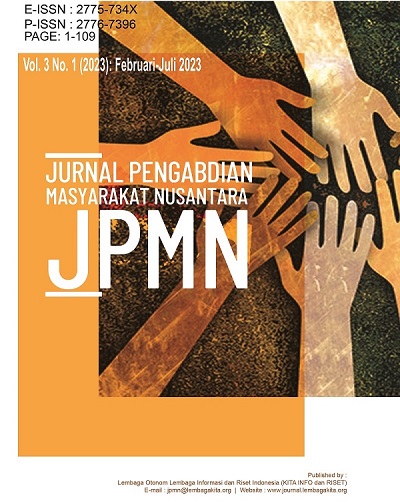Published: 2023-07-04
Peningkatan Skill Dibidang Multimedia Tingkat Sekolah Menengah Kejuruan
DOI: 10.35870/jpmn.v3i1.1293
Marini, Sarwindah, Yurindra
- Marini: ISB Atma Luhur , Indonesia
- Sarwindah: ISB Atma Luhur , Indonesia
- Yurindra: ISB Atma Luhur , Indonesia
Article Metrics
- Views 0
- Downloads 0
- Scopus Citations
- Google Scholar
- Crossref Citations
- Semantic Scholar
- DataCite Metrics
-
If the link doesn't work, copy the DOI or article title for manual search (API Maintenance).
Abstract
Multimedia has entered an expertise program that is in great demand and has many opportunities in the 4.0th Industrial Revolution era because many companies need IT workers in the Multimedia field to introduce their companies and advance their businesses. The purpose of the test is to improve multimedia skills, to be able to master expertise in their area, not only to be able to work for companies but also to have a very important opportunity to create jobs or own a business. Mastery in designing multimedia products as well as mastery of techniques in making multimedia effects and creativity in presenting designed products. Themes in multimedia such as video making design, video editing, effects, moving animation in audio visual management, product design such as video formats, cover labels, DVDs and packing. The result of increasing expertise in the form of Video Design, Brochures is the achievement of the skills aspect consisting of preparation, implementation, design results.
Keywords
Adobe Photoshop ; Product Design ; Multimedia
Article Metadata
Peer Review Process
This article has undergone a double-blind peer review process to ensure quality and impartiality.
Indexing Information
Discover where this journal is indexed at our indexing page to understand its reach and credibility.
Open Science Badges
This journal supports transparency in research and encourages authors to meet criteria for Open Science Badges by sharing data, materials, or preregistered studies.
How to Cite
Article Information
This article has been peer-reviewed and published in the Jurnal Pengabdian Masyarakat Nusantara (JPMN). The content is available under the terms of the Creative Commons Attribution 4.0 International License.
-
Issue: Vol. 3 No. 1 (2023)
-
Section: Articles
-
Published: %750 %e, %2023
-
License: CC BY 4.0
-
Copyright: © 2023 Authors
-
DOI: 10.35870/jpmn.v3i1.1293
AI Research Hub
This article is indexed and available through various AI-powered research tools and citation platforms. Our AI Research Hub ensures that scholarly work is discoverable, accessible, and easily integrated into the global research ecosystem. By leveraging artificial intelligence for indexing, recommendation, and citation analysis, we enhance the visibility and impact of published research.




-
-
-
-
-
-
-
-
-
K. T. K. Neo, M. & Neo, “Innovative teaching: Using multimedia in a problem-based learning environment.,” 2001. [Online]. Available: (http://ifets.ieee.org/periodical/vol_4_2001/neo.html).
-
-
R. Vaughan, “Multimedia: What it is and What it can do for our Students.” [Online]. Available: (http://jaltcall.org/cjo/5_00/vaughan. html).

This work is licensed under a Creative Commons Attribution-NonCommercial-NoDerivatives 4.0 International License.
Authors who publish with this journal agree to the following terms:
1. Copyright Retention and Open Access License
Authors retain copyright of their work and grant the journal non-exclusive right of first publication under the Creative Commons Attribution 4.0 International License (CC BY 4.0).
This license allows unrestricted use, distribution, and reproduction in any medium, provided the original work is properly cited.
2. Rights Granted Under CC BY 4.0
Under this license, readers are free to:
- Share — copy and redistribute the material in any medium or format
- Adapt — remix, transform, and build upon the material for any purpose, including commercial use
- No additional restrictions — the licensor cannot revoke these freedoms as long as license terms are followed
3. Attribution Requirements
All uses must include:
- Proper citation of the original work
- Link to the Creative Commons license
- Indication if changes were made to the original work
- No suggestion that the licensor endorses the user or their use
4. Additional Distribution Rights
Authors may:
- Deposit the published version in institutional repositories
- Share through academic social networks
- Include in books, monographs, or other publications
- Post on personal or institutional websites
Requirement: All additional distributions must maintain the CC BY 4.0 license and proper attribution.
5. Self-Archiving and Pre-Print Sharing
Authors are encouraged to:
- Share pre-prints and post-prints online
- Deposit in subject-specific repositories (e.g., arXiv, bioRxiv)
- Engage in scholarly communication throughout the publication process
6. Open Access Commitment
This journal provides immediate open access to all content, supporting the global exchange of knowledge without financial, legal, or technical barriers.
